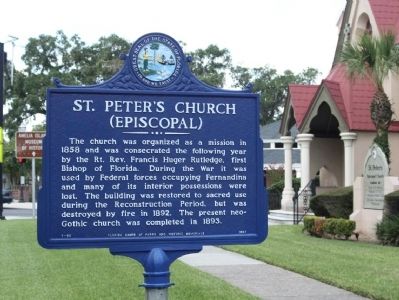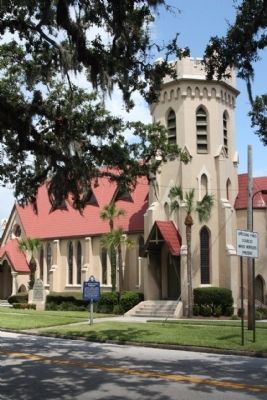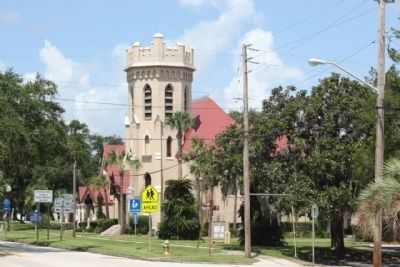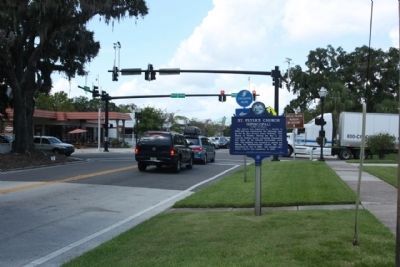Fernandina Beach in Nassau County, Florida — The American South (South Atlantic)
St. Peter's Church
(Episcopal)
Erected 1961 by Florida Board of Parks and Historic Memorials. (Marker Number F-50.)
Topics. This historical marker is listed in this topic list: Churches & Religion. A significant historical year for this entry is 1858.
Location. 30° 40.246′ N, 81° 27.509′ W. Marker is in Fernandina Beach, Florida, in Nassau County. Marker is on Atlantic Avenue (State Route 200) (State Road A1A) near 8th Street, on the right when traveling west. Located on Amelia Island, Historic Fernandina Beach. Touch for map. Marker is at or near this postal address: 801 Atlantic Avenue, Fernandina Beach FL 32034, United States of America. Touch for directions.
Other nearby markers. At least 8 other markers are within walking distance of this marker. The Good Shepherd Church 1887-1966 (about 300 feet away, measured in a direct line); First Missionary Baptist Church of Fernandina (about 400 feet away); New Zion Baptist Church (about 500 feet away); Trinity United Methodist Church (about 500 feet away); Memorial United Methodist Church (about 600 feet away); First Presbyterian Church (about 700 feet away); Nassau County American Revolutionary War Memorial (approx. 0.2 miles away); Nassau County Historic Courthouse (approx. 0.2 miles away). Touch for a list and map of all markers in Fernandina Beach.
Regarding St. Peter's Church. "In 1974 the Historic American Buildings Survey produced detailed line drawings of St. Peter’s Church, which are today housed in the Library of Congress."
"Major renovation and repair work was performed during the 1980’s and 1990’s. The church exterior was reworked, the stained glass windows were removed, restored and replaced with a protective exterior covering, and the Harrison organ was restored. The roof was replaced with every effort made to match the original design and color."
Also see . . . From the St. Peter''s Church website:. "Often called "The Jewel of Centre Street" this church is a textbook example of Gothic Revival architecture designed by noted architect Robert Sands Schuyler. It features lancet, arch-shaped windows, a steeply pitched roof, buttressed walls and a tower with a castellated parapet. The tabby walls are 18" thick and overlaid with cement. Originally constructed 1881-84, it was severely damaged by fire in 1892, resulting in some minor changes to its appearance: the original spire was not rebuilt, but elaborate entrances were added, along with the chien assi ("sitting dog") windows in the roof. Following the fire, the east end of the church was extended 7 feet to provide space for an elaborate Harrison pipe organ which was dedicated on the evening of November 14, 1893." (Submitted on August 27, 2012, by Mike Stroud of Bluffton, South Carolina.)
Credits. This page was last revised on February 10, 2018. It was originally submitted on August 27, 2012, by Mike Stroud of Bluffton, South Carolina. This page has been viewed 643 times since then and 46 times this year. Photos: 1, 2, 3, 4. submitted on August 27, 2012, by Mike Stroud of Bluffton, South Carolina.



